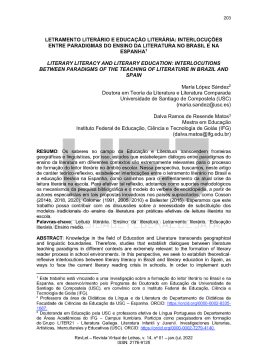Cuando llueve NO se moja como los demás. Repensar los espacios comunes de la escuela a través de ArtEducación

Doctoral research in music education in Brazil: meta-analysis and thematic trends of 300 theses
18 February 2022
Impact of the use of audiovisual materials for the learning of traditional dances in the training of university students
21 February 2022Cuando llueve NO se moja como los demás. Repensar los espacios comunes de la escuela a través de ArtEducación
Year of publication:
2019
Related links
How to quote
Trigo Martínez, C. (2019). Cuando llueve NO se moja como los demás. Repensar los espacios comunes de la escuela a través de ArtEducación. Invisibilidades. Revista Ibero-Americana de pesquisa em Educação, Cultura e Artes, (11). 87-97. DOI 10.24981.16470508.11.12
Abstract
This proposal focuses on the common spaces of the school (playground, transit spaces, green areas…) as areas from which to generate Community ArtEducational projects taking values as reference contemporaries that art demands. The schoolyard is one of the first spaces for socialization. A common space with diverse people in which boys and girls spend many hours; where they learn to relate to others, learn about other experiences; coexist, understand, share (Ciocoletto, 2016). In this space different situations and dynamics simultaneously born, usually in the form generic games (Pi i Murugó, 2016). Is not easy. The educational context is complex: compartmentalized hours and spaces, security, scarce resources… thus, the “playground” time is often considered a transit time, far from being conceived as a space of opportunity for social interaction and learning from the playful nature that it must have, beyond the classroom. We need to delve into reflection about the role they should play these spaces from a current perspective of education and art. The schools that consider adapting them to new needs are increasing and the educational community but also collectives intervene in this change, architects and artists or diverse institutions that collaborate in the study and development of intervention proposals for these spaces. The project “Cuando llueve se moja como los demás. Repensar los patios a través de la ArtEducación” is part of the subject of Plastic and Visual Education II: Artistic processes and projects (3rd year, Master’s Degree in Education Primary, University of Santiago de Compostela) from which I propose to the students: analyse the experience lived in the common spaces of the schools as students and intern teachers (memories, dynamics, types of games, roles); think about the uses and organization of the common spaces of the schools; develop hypotheses about the possibilities of such spaces as areas in which to generate community projects from the intervention artistic; devise and create objects that collect the basic characteristics of the intervention; and try to put some of the proposals into practice. And in this journey we are asking ourselves questions with which we build ideas collectively; we analyse the game as a model, the education that we want, the possibility of creating Micro-utopias or the playgrounds that we want build from premises such as projects-artistic learning process designed as instruments to help students and teachers to learn and to experience art, to develop their artistic self-education and influence the practice in a critical way, in the actual curriculum, in what goes on inside and outside of the classrooms.



